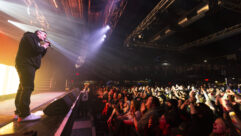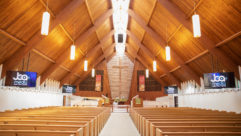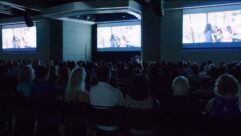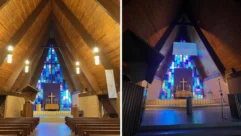
The Buzz: Installation Spotlight: First United Methodist Church, Thomasville, Ga.
Jul 1, 2007 12:00 PM,
By Jessaca Gutierrez
Historically Respectful Sound

Because older churches lack structural accommodation for modern sound systems, designers seeking to update the acoustics in these churches often face a delicate balance between preserving historic architecture and delivering intelligible sound.
Few acoustic challenges are greater than the issue of designing adequate sound for historical structures during retrofit or upgrade jobs — particularly in the houses of worship market. Older churches might enjoy a classic acoustical design to carry natural sound, but they often lack architectural accommodations for a modern sound system that has been acoustically fitted to the space. This makes upgrading them with a modern sound system a challenge. The mission of preserving the historical architecture of such facilities without sacrificing intelligible audio can be a vexing one for integrators on such jobs.
At the First United Methodist Church of Thomasville, Ga., the need to preserve the historic structure had prevented the church from completing a much-needed audio upgrade for years. The church dates back to the late 1800s, so preserving the original structure was essential. Several years ago, the church did attempt to combine what was then modern audio technology with the church’s traditional architecture, which meant concealing the system as much as possible. At that time, a contractor cut three diamond-shaped holes in the sanctuary’s ceiling: one above the front of the congregation, one at the rear, and one over the choir. The system they installed consisted of ceiling-mounted Frazier cabinets and custom boxes made to fit the cutouts in the ceiling. Crown Com-Tech series amplifiers were used to power the ceiling loudspeakers, and a Mackie 2404 mixing console was placed at the front-of-house position. The holes were covered with grille cloth to match the ceiling.
Although that system served the congregation for several years, the audio had reached the point where a more extensive upgrade was required.

The church went with Renkus-Heinz IC8 loudspeakers, which it custom painted to match the walls they were mounted on in order to preserve the aesthetics of the church’s historic structure.
The church contacted S&L Productions, based in nearby Cairo, Ga., to propose upgrades to the church’s outdated system. The first steps were to modernize the electronics, starting with a Juice Goose CQ1520 power sequencer and conditioner. An Audix Micropod18-HC gooseneck microphone was installed in the podium. A Soundcraft LX7ii console allowed more microphones and monitor mixes. S&L programmed a Biamp Nexia SP digital signal processor (DSP) to equalize and delay the old ceiling-mounted loudspeakers.
“The only equalization [previously] was a Sabine feedback destroyer, which would not constitute as really equalization because it only took out frequencies that would feed back in the room,” says S&L Productions President Jason Jones. “We installed the Biamp Nexia SP to have equalization, limiting to the house and monitors, as well as a compressed record output for the radio feed, which they broadcast onto a local AM radio station.”
Although each of these upgrades resulted in significant improvements, it was clear the old ceiling-mounted system had to go. The church’s architecture literally spoke volumes why the old system wasn’t suitable: The room was originally designed in the late 1800s to carry natural voice, without any help from modern audio technology. The old ceiling-mounted system therefore created more reverb in the room because of all the hard surfaces and uncontrolled dispersion of the old loudspeaker system. A new directional system was needed to control the reverb and keep the sound from bouncing off the walls.
After doing some EASE models, Jones and independent manufacturer’s representative Richard Hembree of Griffith Sales Associates in Powder Springs, Ga., decided that Renkus-Heinz Iconyx digitally steerable array systems would provide the right sound quality for the church, and still preserve the aesthetics and structure of the building.
Jones put on a demo of the IC16 and IC8 arrays so the congregation could hear what a difference the system made, and they were impressed. Although the IC16 produced better results controlling lower frequencies, the congregation opted for lower-priced IC8 system.
In contrast to older loudspeakers that use acoustical devices such as horns to control sound energy, Iconyx uses digital technology. Iconyx arrays are assembled as multiples of the IC8 module. Each IC8 has eight coaxial full-range transducers, and each of those is individually controlled by its own amplifier channel with onboard DSP. BeamWare software calculates the FIR (Finite Impulse Response) filters that must be used to achieve a specific coverage pattern: Beams of acoustical energy can be as narrow as 10 degrees in the vertical plane, and 140 degrees horizontally.
The Iconyx sound beams allow for significant gain before feedback. SPL varies less than +/-2dB throughout the entire room. The 140-degree horizontal dispersion allows the system to provide sound to the transepts, as well as the main sanctuary.
The IC8 loudspeakers are 6in. wide and a little more than 3ft. tall, and can be mounted flush against a wall with the sound aimed at the audience, and away from walls and ceilings that cause reverberation. Although the loudspeakers are visible in such configurations, they can be painted to match the walls they are mounted on, which makes them blend in more.
But there was also concern about mounting the loudspeakers on walls that were more than 100 years old.
“We were concerned with the wall being able to hold the weight of the speaker, and asked the church to have a local engineer verify the wall could hold the speakers,” Jones says. “He okayed the mounting placement. The speakers were mounted to the 100-year-old plaster — no problem. The brackets for the Iconyx speakers are wonderful, and give the installer many holes for maximum flexibility.”
The biggest challenge, however, was wiring the new system. Because the church was built in late 1800s, there was limited existing wiring. Jones contracted with a local electrical contractor to do the job.
“New cable was pulled from the first floor under the sanctuary up the wall in the attic, then back down from the attic to the wall where the new speakers were located left and right in the room,” Jones says. “Power was also pulled to the new loudspeaker locations to power up the loudspeakers, which are sequenced on from the rear of the room using a Juice Goose CQ1520 with remote switch.”
S&L Productions also recently installed two Wharfedale Programme 50 loudspeakers that were mounted on mic stands just behind the choir modesty rail for choir foldback.
SUBSCRIBE TO SOUND & VIDEO CONTRACTOR E-NEWSLETTERS!
- Sound & Video Contractor EXTRA
Systems Integration Special Focus series:
- Houses of Worship
- Corporate AV
- Residential AV
- AV Over Fiber
- AV in Education
Breaking industry news in your email inbox every other week!
Subscribe atwww.svconline.com










